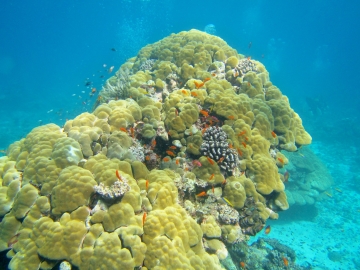SATS print 229_360 px width.jpg

A healthy reef is noisy. When looking for a place to settle, coral larvae are attracted to the sounds of healthy reefs. Credit: Frédéric Ducarme, CC BY-SA 4.0
If you knew that where you settled down would be home for the rest of your life, you’d make sure it was the best neighborhood you could find. That’s the situation larval corals face as they drift with ocean currents looking for the reef that will become their forever home. Light and chemicals in the seawater play a role in where larvae settle, but scientists recently discovered another factor: how the neighborhood sounds.
Just as people might avoid homes near railroad tracks or an airport, larval coral pay attention to sounds when home shopping. But instead of peace and quiet, coral larvae listen for the rich soundscape of a thriving coral reef. Reefs heavily damaged by coral bleaching, disease or human behavior are far quieter, without the noises of fish, shrimp, and other animals in a healthy ecosystem.
Researchers discovered this from experiments in the U.S. Virgin Islands in the summer of 2022. They placed cups of mustard hill coral larvae along three reefs on St. John’s southern coast. Cocoloba Reef and Salt Pond Reef have few corals and fishes, but the third reef, Tektite Reef, is relatively healthy. The scientists set out cups at various distances from underwater speakers at each reef. Then they played healthy reef sounds, recorded a decade earlier at Tektite Reef, for three days—but only through the Salt Pond speakers.
Nearly twice as many larvae settled in the Salt Pond cups than the other reefs’ cups. Though cups closer to the speaker had the most larvae, even those 30 meters from Salt Pond speakers had more larvae than at the other reefs. Cocoloba and Tektite had similar settlement rates, the researchers suggested, likely because Tektite has suffered degradation from hurricanes, bleaching, and disease in more recent years and may not sound as inviting as it once did. These results also suggest that sound could be a useful tool for repopulating damaged reefs.


